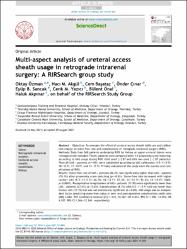| dc.contributor.author | Özman, O. | |
| dc.contributor.author | Akgül, Hacı Murat | |
| dc.contributor.author | Başataç, C. | |
| dc.contributor.author | Çınar, Ö. | |
| dc.contributor.author | Sancak, E.B. | |
| dc.contributor.author | Yazıcı, Cenk Murat | |
| dc.contributor.author | Önal, B. | |
| dc.date.accessioned | 2023-05-06T17:22:12Z | |
| dc.date.available | 2023-05-06T17:22:12Z | |
| dc.date.issued | 2022 | |
| dc.identifier.issn | 2214-3882 | |
| dc.identifier.uri | https://doi.org/10.1016/j.ajur.2021.11.004 | |
| dc.identifier.uri | https://hdl.handle.net/20.500.11776/12109 | |
| dc.description.abstract | Objective: To evaluate the effect of ureteral access sheath (UAS) use and calibration change on stone-free rate and complications of retrograde intrarenal surgery (RIRS). Methods: Data from 568 patients undergoing RIRS for kidney or upper ureteral stones were retrospectively included. Firstly, patients were compared after 1:1 propensity score matching, according to UAS usage during RIRS (UAS used [+] 87 and UAS non-used [?] 87 patients). Then all UAS+ patients (n=481) were subdivided according to UAS calibration: 9.5–11.5 Fr, 10–12 Fr, 11–13 Fr, and 13–15 Fr. Primary outcomes of the study were the success and complications of RIRS. Results: Stone-free rate of UAS+ patients (86.2%) was significantly higher than UAS? patients (70.1%) after propensity score matching (p=0.01). Stone-free rate increased with higher caliber UAS (9.5–11.5 Fr: 66.7%; 10–12 Fr: 87.3%; 11–13 Fr: 91.3%; 13–15 Fr: 100%; p<0.0001). Postoperative complications of UAS+ patients (11.5%) were significantly lower than UAS? patients (27.6%) (p=0.01). Complications (8.7%) with 9.5–11.5 Fr UAS was lower than thicker UAS (17.3%) but was not statistically significant (p=0.08). UAS usage was an independent factor predicting stone-free status or peri- and post-operative complications (odds ratio [OR] 3.654, 95% confidence interval [CI] 1.314–10.162; OR 4.443, 95% CI 1.350–14.552; OR 4.107, 95% CI 1.366–12.344, respectively). Conclusion: Use of UAS in RIRS may increase stone-free rates, which also increase with higher caliber UAS. UAS usage may reduce complications; however, complications seemingly increase with higher UAS calibration. © 2022 Editorial Office of Asian Journal of Urology | en_US |
| dc.language.iso | eng | en_US |
| dc.publisher | Editorial Office of Asian Journal of Urology | en_US |
| dc.identifier.doi | 10.1016/j.ajur.2021.11.004 | |
| dc.rights | info:eu-repo/semantics/openAccess | en_US |
| dc.subject | Kidney | en_US |
| dc.subject | Retrograde intrarenal surgery | en_US |
| dc.subject | Stone | en_US |
| dc.subject | Ureteral access sheath | en_US |
| dc.subject | Urolithiasis | en_US |
| dc.title | Multi-aspect analysis of ureteral access sheath usage in retrograde intrarenal surgery: A RIRSearch group study | en_US |
| dc.type | article | en_US |
| dc.relation.ispartof | Asian Journal of Urology | en_US |
| dc.department | Fakülteler, Tıp Fakültesi, Cerrahi Tıp Bilimleri Bölümü, Üroloji Ana Bilim Dalı | en_US |
| dc.institutionauthor | Akgül, Hacı Murat | |
| dc.institutionauthor | Yazıcı, Cenk Murat | |
| dc.relation.publicationcategory | Makale - Uluslararası Hakemli Dergi - Kurum Öğretim Elemanı | en_US |
| dc.authorscopusid | 57191474931 | |
| dc.authorscopusid | 57220590363 | |
| dc.authorscopusid | 42161159900 | |
| dc.authorscopusid | 57189872977 | |
| dc.authorscopusid | 55753628300 | |
| dc.authorscopusid | 8416588900 | |
| dc.authorscopusid | 7003794104 | |
| dc.identifier.scopus | 2-s2.0-85141761145 | en_US |



















